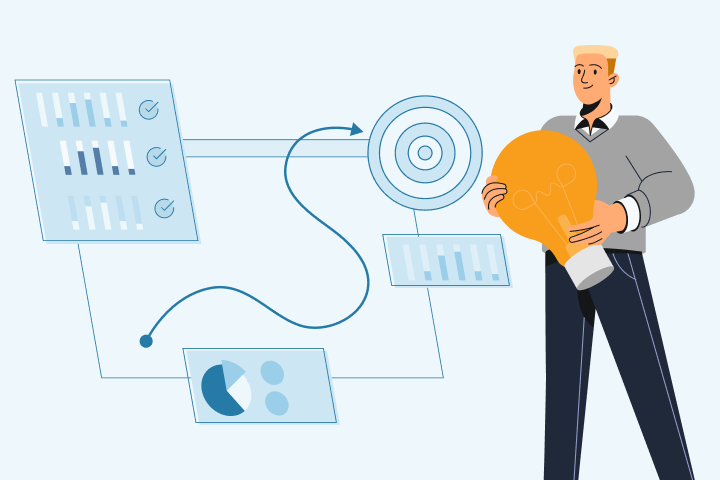The Benefits of Employee Advocacy: How It Impacts Growth
Employee advocacy is an increasingly popular content amplification strategy, though its benefits extend well beyond simply increasing social media engagement.
Many of our customers use it to meaningfully improve key metrics that impact revenue, from recruiting top talent to increasing demand and sales.
In this post, we’ll discuss some additional benefits of employee advocacy and how it can help brands achieve critical growth goals.
What Is Employee Advocacy?
Employee advocacy is a marketing strategy where employees spread brand messages (usually via social media) with their professional networks.
An example of employee advocacy is an employee sharing or commenting on a LinkedIn post published on the company page or by the company. Here’s a great example from an Airbnb employee:
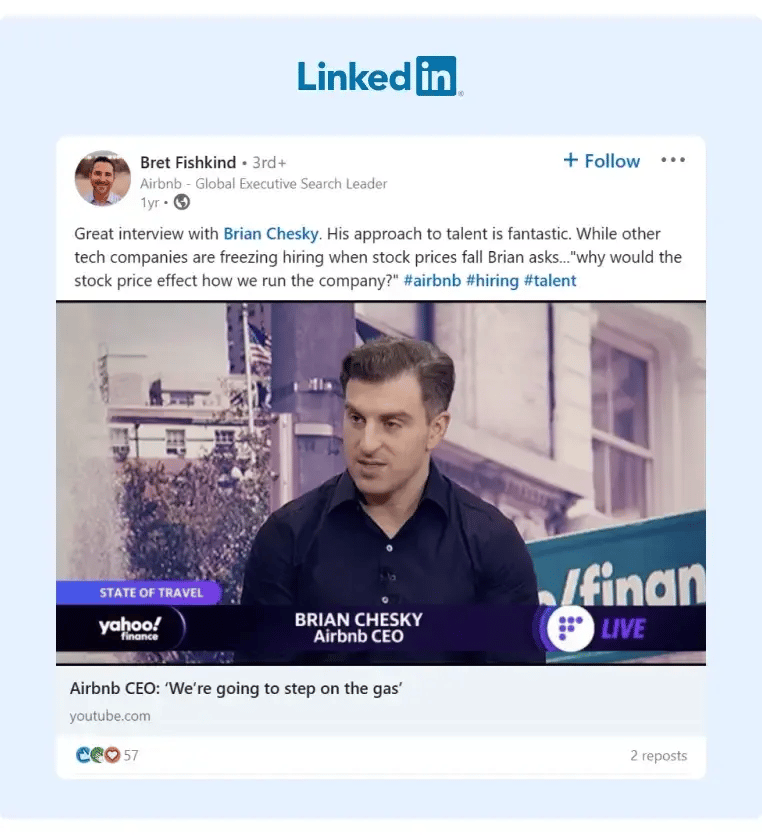
Source: Bret Fishkind
When employees engage with the brand's content, social algorithms usually show that same content to at least a portion of their social network.
Another example of employee advocacy is an employee creating their own social media post regarding a specific brand initiative. For example, they might create a post on their own LinkedIn profile that announces their team is hiring for a new position.
Or, if you’re trying to promote company culture, employees could create a post describing their favorite aspects of the company culture. Here’s a great example from Semrush:

Source: Yuliya B.
In short, employee advocacy is similar to influencer marketing, but instead of hiring influencers to promote the content, the employees promote it to their social networks.
We have a few resources where you can learn more about what employee advocacy is and how to implement an employee advocacy strategy for your brand. However, this post discusses six specific benefits of an employee advocacy program.
Benefit #1: Increase Brand Awareness
The total size of your employees' combined networks usually surpasses (or at least rivals) the company page's total number of followers.
For example, the company page might have 5,000 followers, but if you have 10 employees with 1,000 connections each, their combined networks provide a potential reach of 10,000.
In this scenario, implementing an employee advocacy program that involves all 10 employees would increase the brand's total potential reach from just the company page's 5,000 followers to a combined potential organic reach of 15,000.
In addition, social media users tend to prefer engaging with other people more than brands.
Posts created or shared by employees and executives tend to generate higher engagement rates than posts published by the company's social media account.
For example, WHOOP shared a new feature release announcement on its brand's account which generated moderate engagement:
However, when WHOOP’s founder promoted the exact same feature release, it generated significantly more engagement:
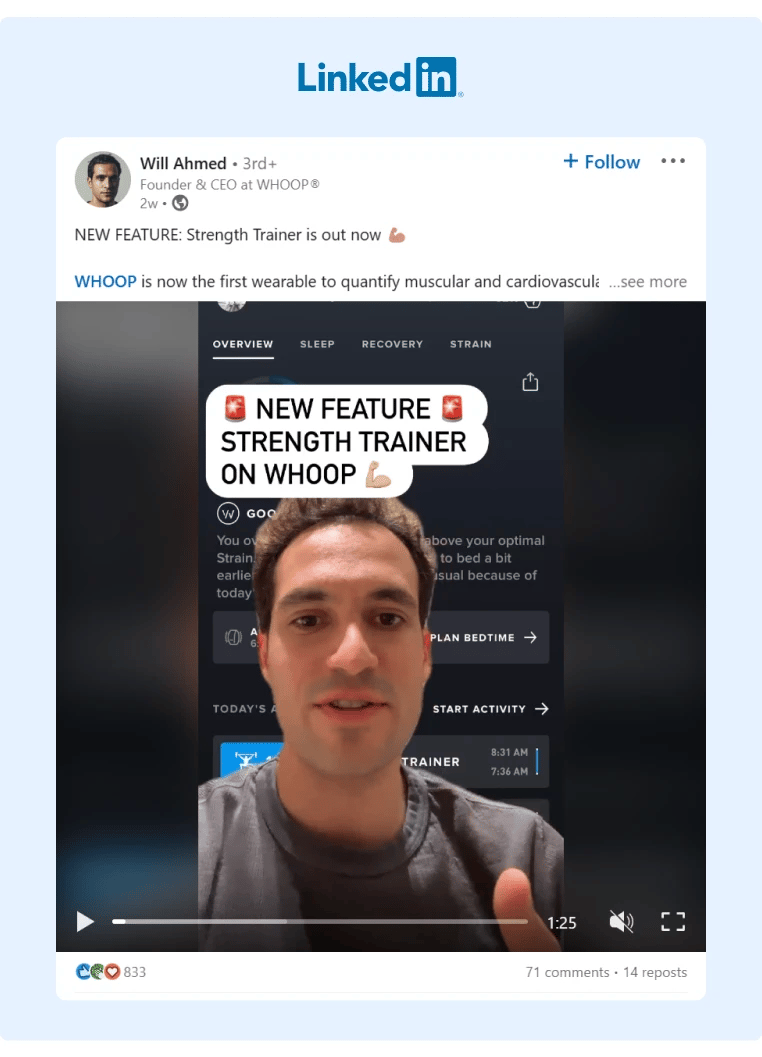 Source: Will Ahmed
Source: Will Ahmed
You'll also notice that engagement quality tends to be higher on posts published by employees than posts published by the brand.
For example, here are a few comments from the executive's post promoting the recent WHOOP Stress Monitor feature release:
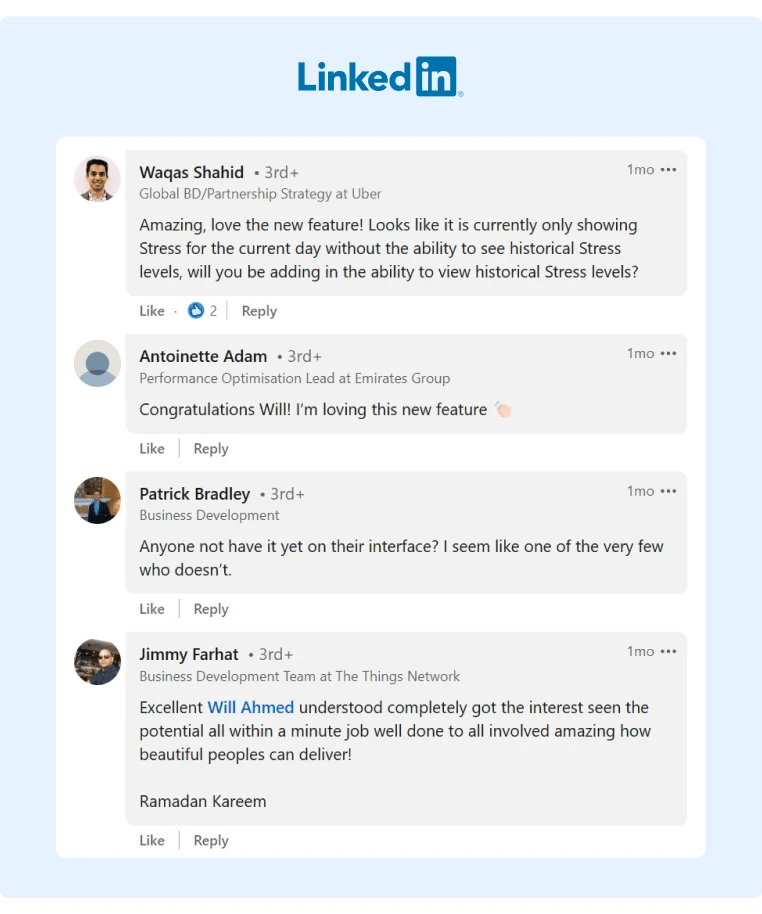
Source: Will Ahmed
The product and marketing team can use these comments to better position the product and even add new feature ideas to their list.
Benefit #2: Improve Brand Reputation and Credibility
Employee advocacy also gives your brand more social proof as it multiplies the company page's total engagement, making it seem much more credible than brands with minimal social engagement.
This engagement helps you build trust with prospects and can even sway them to choose your brand over an unknown competitor.
If you're selling higher-priced products with longer buyer journeys where prospects carefully consider multiple options, having an engaged social media profile is critical to boosting prospects' trust with your brand.
For example, if you’re looking for a payments provider, selecting a trustworthy provider is a top priority.
If your brand has significantly more positive social media engagement than the competition (even if the initial engagement is from your own employees), that's a very good sign to prospects that your brand is reliable, steady, and secure.
For example, if you scroll through Stripe’s LinkedIn profile, you’ll see that each post generates, on average, a few hundred likes, a handful of shares, and about 10-30 comments. This is a positive sign that the brand is trustworthy and credible.
In addition, as your own employees begin engaging with content, their connections will probably start engaging with your brand's content, which further amplifies your brand reach and even word-of-mouth marketing.
Benefit #3: Close More Deals Faster
If your sales team participates in your employee advocacy program, they'll likely be able to increase total sales and shorten the sales process.
Here's how.
First, if your sales team regularly posts relevant content on social media, they'll organically grow their networks, they'll have access to a larger pool of potential customers when they promote the brand.
This method is sometimes referred to as social selling, and it's highly effective because people like to buy tools from people they trust. This post is excellent proof of that:
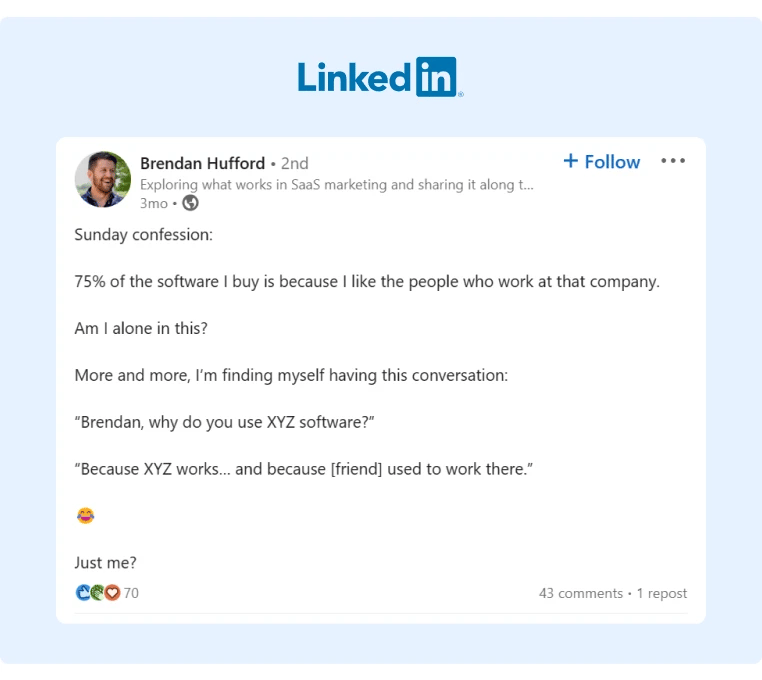
Source: Brendan Hufford
Fortunately, consistently engaging (authentically) on social media is a great way to build relationships.
When a connection needs a tool that your company offers, your brand will come to mind first because that connection already likes and trusts your employees.
Employee advocacy also shortens the sales cycle because the sales team doesn't have to spend as much time building rapport with prospects.
Additionally, if employees consistently create content that explains key customer pain points and how the tool/service solves specific pain points, they'll attract higher quality prospects as only people who resonate with those pain points will reach out.
Prospects will also walk into the sales call with at least a basic understanding of how the product works, which can shorten the sales process by eliminating follow-up calls and questions.
Benefit #4: Attract Top Talent
As employees share insightful perspectives on industry news, more and more people will follow them and look up to them as thought leaders.
This helps your brand organically attract top talent because A players want to work with respected thought leaders. So, when you have a new job opening, you can simply ask your employees to share it with their networks. And you'll probably attract a handful of talented passive job seekers that wouldn't respond to a generic job post published on the company page.
Here's a great example of an employee who regularly engages with company content and has established herself as a thought leader. As a result, her post promoting a new job at Crumbl received excellent, high-quality engagement:
You can see in the comments that this post generated interest from plenty of applicants:

Source: Alejandra Caceres
Benefit #5: Relatively Fast ROI
One of the drawbacks of social media content is that it usually takes time for companies to grow their organic following, which means the ROI can be slow to materialize.
This is a key reason many companies turn to influencer marketing and paid ads to speed up growth and generate an ROI faster.
Fortunately, employee advocacy provides a similarly fast ROI to other paid promotion tactics, as you'll immediately see a boost in engagement when employees promote your content to their networks. However, unlike other paid promotion tactics, it doesn't require the same upfront investment.
Employee advocacy is also one of the most cost-effective promotion methods, and it tends to generate higher quality engagement than other forms of paid promotion.
Benefit #6: Improve Employee Engagement
Another benefit of employee engagement is that it keeps employees up-to-date with the latest company news and initiatives.
For example, let's say there's a new feature that the engineering team just released. If you create a post on the company page announcing the feature release and then request the entire team to create content regarding that feature, the marketing team might then realize that they might need to incorporate that feature into their messaging.
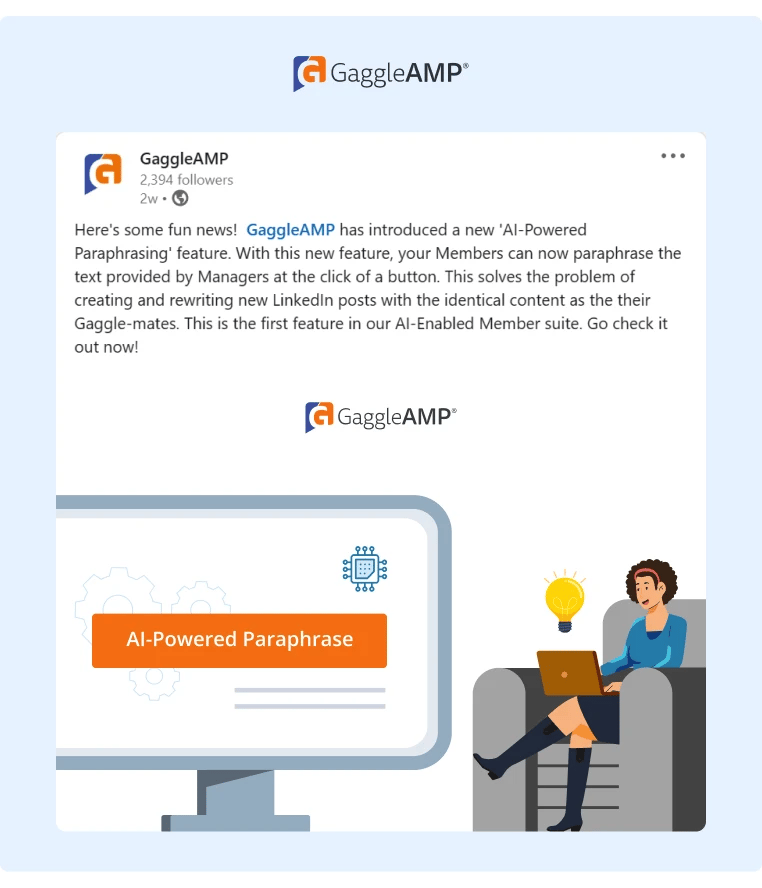
However, if you hadn't created that engagement request, the marketing team might not have ever realized the new feature existed as they might not talk to the engineering team on a regular basis.
In addition, it's easy for employees at bigger companies to lose sight of the brand's general vision and mission.
Employee advocacy can combat misalignment because employees will frequently visit branding guidelines to ensure what they say is on brand and aligns with the company's overall mission and vision.
If employees say something that doesn't align with the brand's mission and vision, it is beneficial as managers can identify problems and address them accordingly.
Finally, if you use an employee advocacy platform like GaggleAMP, you can incorporate friendly competition by using a public leaderboard that ranks employees by engagement.
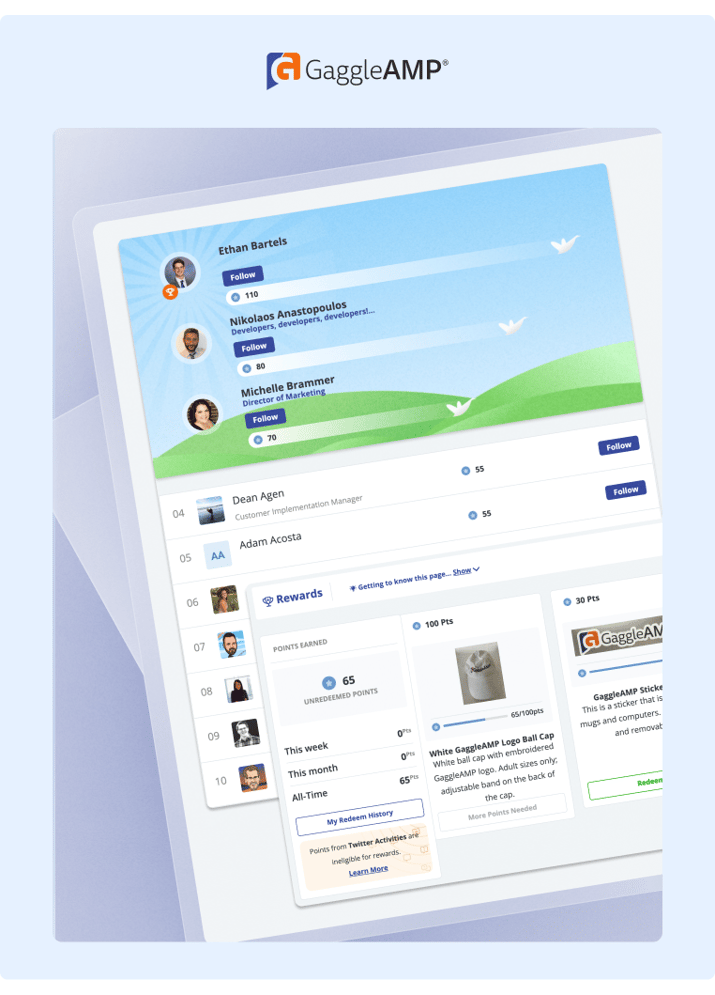
The benefit of the leaderboard is that it allows you to reward employees for engagement, which also helps you build a culture that values thought leadership and brand advocacy.
There are also plenty of other benefits of an engaged employee workforce, like better employee retention, more productive teamwork, and more recruiting referrals from employees.
Implementing an Employee Advocacy Strategy
After reading about these benefits, you're probably wondering why more brands don't implement an employee advocacy strategy.
Unfortunately, the logistics of running an employee advocacy program are rather tricky and many social media managers find that their employees tend to quit engaging after your first few requests.
Here are just a few reasons why employee advocates tend to disengage after a few weeks:
- Employees don't recognize the benefits of employee advocacy and therefore don't believe that it justifies the time commitment required.
- Employees are afraid they'll say something that doesn't align with the brand.
- Employees don't know how to engage or what content they should engage with.
Unfortunately, it's difficult to manually provide personalized guidance for employees and detailed metrics demonstrating the value of their efforts.
The good news is that you can solve these problems by using an employee advocacy tool.
GaggleAMP is an example of an employee advocacy tool, and it allows you to provide personalized engagement activities for employees at scale.
For example, you can create an engagement activity with specific instructions such as, "Comment on this feature release post we just published with a reason why you're excited about it and how it will help customers."

From there, you can assign that post to a group of employees (like the marketing or sales team). Providing employees with specific instructions eliminates most of the confusion associated with employee advocacy that causes them to quit engaging.
GaggleAMP also provides a detailed analytics dashboard with metrics like total brand reach, engagement, and even a breakdown of the most successful social channels, brand advocates, and content.
You can then use this data to show employees the value of their engagement efforts, which further encourages them to participate in your brand advocacy strategy.
To see for yourself how GaggleAMP can help you build a successful employee advocacy program, schedule a demo today.





